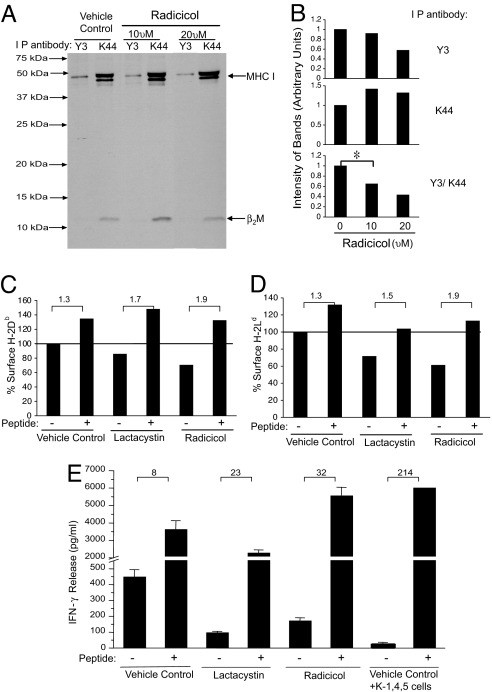Fig. 2.
Inhibition of hsp90 results in appearance of empty surface MHC I. (A) EL4 cells were treated with the indicated dose of radicicol or DMSO for 12 h. Cells were metabolically labeled with 35S for 3 h and lysed for immunoprecipitation with Y3 (specific for conformational H-2Kb) or K44 (recognizing total mouse MHC I). An autoradiograph representative of two independent experiments is shown. (B) The intensity of the Y3 (conformation-dependent) or K44 (conformation-independent) immunoprecipitated MHC class I bands from autoradiograph (A) was quantitated in arbitrary units (Top and Middle). The ratio the intensity of Y3 (conformation-dependent H-2Kb) to K44 (total conformation-independent MHC I) was calculated in arbitrary units (Bottom). The reduction in the Y3/K44 ratio seen in presence of 10 μM radicicol is statistically significant (P = 0.008, two-tailed test). (C) SVB6 cells were treated with 10 μM lactacystin, 10 μM radicicol, or DMSO for 12 h in the presence or absence of the Db-restricted T antigen epitope II peptide (CKGVNKEYL). Cells were stained with a Db conformation-specific antibody or isotype control and analyzed as in Fig. 1B. (D) 4T1 cells were treated with 20 μM lactacystin, 30 μM radicicol, or DMSO for 12 h in the presence or absence of the Ld-restricted LCMV-NP peptide (RPQASGVYM). Cells were stained and analyzed as in Fig. 1B. (E) T antigen-expressing SVB6 cells were treated with the indicated doses of lactacystin, radicicol, or a vehicle for 12 h in the presence or absence of the T antigen epitope I peptide (SAINNYAQKL). The T antigen epitope I-deficient K-1, 4, 5 cell line was used as a negative control. Treated cells were added as stimulators of K11 cells (a T antigen epitope I-specific T cell clone) for 20 h, and supernatant was assayed for IFN-γ. Results of three independent experiments (each in duplicate) are plotted, with error bars representing the standard deviation between the averages of duplicate samples.

